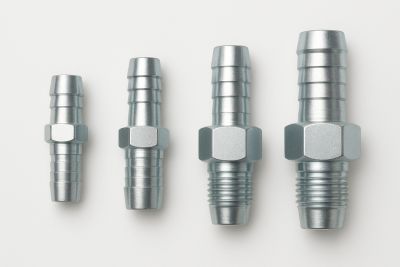Hydraulic and pneumatic systems are the backbone of countless industrial applications, from construction machinery and manufacturing lines to marine and mining operations.
While hydraulic systems use pressurized fluids to transmit power, pneumatic systems rely on compressed air or gas. Both operate under high-pressure conditions where every connection must be secure and leak-free to maintain efficiency, safety, and system reliability.
What Are Swage Nipples?
A swage nipple is a type of pipe fitting used to connect two sections of pipe with different diameters, unlike a reducer, which often uses flanges or couplings. A swage nipple offers a compact, direct, and leak-proof connection.
The nipple has two ends: one larger and one smaller. The larger end connects to the bigger pipe, and the smaller end connects to the smaller pipe, allowing a smooth transition in diameter. This ensures consistent flow without turbulence or pressure loss.
Common Materials Used
Swage nipples are typically manufactured from:
➡️ Carbon Steel – for strength and high-pressure durability
➡️ Stainless Steel – for corrosion resistance and clean environments
➡️ Brass or Alloy Steel – for specialized applications or enhanced performance
Types of Swage Nipples
Concentric vs. Eccentric Swage Nipples
➡️ Concentric Swage Nipples: Have both ends aligned along the same centerline. Ideal for vertical installations and even flow distribution.
➡️ Eccentric Swage Nipples: Feature offset ends to prevent air pockets and ensure smooth flow, commonly used in horizontal pipelines.
Threaded vs. Plain End Types
➡️ Threaded Ends: Used where easy assembly and disassembly are required, compatible with BSP or NPT threads.
➡️ Plain Ends: Designed for welded or socket-weld applications, offering permanent and high-strength connections.
BSP, NPT, and Metric Standards Explained
1. BSP (British Standard Pipe) – Common in Europe and Asia
2. NPT (National Pipe Thread) – Widely used in North America
3. Metric Threads – Used in specialized international systems
Why Heavy-Duty Swage Nipples Matter
Built for High-Pressure and Heavy-Load Applications
Heavy-duty swage nipples are engineered to withstand extreme pressures and loads, ensuring uninterrupted performance even in the most demanding conditions.
Enhanced Strength and Durability
These fittings are heat-treated and precision-machined to deliver superior tensile strength and fatigue resistance, reducing the risk of failure.
Leak Prevention and Safety Benefits
Properly designed and installed swage nipples prevent fluid leaks, ensuring safety, environmental compliance, and operational efficiency.
Applications in Hydraulic and Pneumatic Systems
Hydraulic Power Units and Machinery
Used to connect pumps, valves, and actuators, ensuring seamless fluid transmission in hydraulic circuits.
Pneumatic Control Systems and Air Compressors
In pneumatic setups, they connect air lines, control valves, and cylinders, maintaining air pressure and flow stability.
Common Industries
Heavy-duty swage nipples are widely used in:
➡️ Oil & Gas
➡️ Construction and Mining
➡️ Manufacturing and Automation
➡️ Marine and Offshore Engineering
➡️ Power Generation
Material and Manufacturing Standards
Manufacturers use materials such as carbon steel, stainless steel, and alloy steel, chosen based on strength, temperature tolerance, and corrosion resistance.
Compliance with International Standards
To ensure quality and interchangeability, reputable swage nipples comply with:
1. ASTM (American Society for Testing and Materials)
2. ASME (American Society of Mechanical Engineers)
3. DIN (German Institute for Standardization)
4. ISO (International Organization for Standardization)
5. BS (British Standards)
Precision Machining and Surface Finishing
Accurate machining ensures perfect fitment and leak-free performance, while smooth finishing enhances corrosion resistance and longevity.
Choosing the Right Swage Nipple
When selecting a swage nipple, consider the following factors:
1. Pressure Rating: Match the nipple’s pressure capacity to the system’s maximum operating pressure.
2. Temperature Range: Ensure material compatibility with the system’s temperature extremes.
3. Fluid Compatibility: Choose materials that resist corrosion or chemical reactions with the fluid.
4. Connection Type and Size: Verify end types (threaded or plain) and correct diameters for a perfect fit.
Pro Tip: Always consult your fitting supplier or engineer to ensure compliance with system requirements and safety standards.
Advantages of Using Quality Heavy-Duty Swage Nipples
➡️ Extended Service Life: High-quality materials and finishes extend operational lifespan.
➡️ Corrosion Resistance: Stainless steel and coated options resist rust, ensuring long-term reliability.
➡️ Improved System Efficiency: Secure, leak-proof joints reduce downtime and energy loss.
➡️ Enhanced Safety: Precision connections minimize risks of pressure failure or fluid leaks.
Installation and Maintenance Tips
➡️ Proper Alignment and Torque: Misalignment can cause leaks or stress on joints; always use recommended torque values.
➡️ Regular Inspection: Check for signs of corrosion, cracking, or wear during routine maintenance.
➡️ Use Compatible Sealing Materials: Apply appropriate thread sealants or gaskets compatible with the system’s fluid type and temperature.
FAQs
Q1: What is the difference between a swage nipple and a pipe reducer?
A swage nipple is a single-piece fitting used for compact installations, while a pipe reducer typically involves flanged or coupled connections, making it bulkier.
Q2: Can swage nipples be reused?
Threaded swage nipples can sometimes be reused if they show no signs of wear or damage. Welded types, however, are typically single-use.
Q3: What pressure ratings are available?
Heavy-duty swage nipples are available in a wide range of pressure classes, typically from 3,000 PSI to 9,000 PSI, depending on the material and design standard.
Conclusion
Heavy-duty swage nipples are essential for maintaining reliability, safety, and performance in hydraulic and pneumatic systems. Their strength, precision, and leak-resistant design make them indispensable in any high-pressure environment.
When selecting fittings, always choose certified, high-quality swage nipples that meet international standards. Doing so ensures optimal system integrity, reduced maintenance costs, and long-term operational safety.
Need guidance? Consult with professional suppliers or hydraulic specialists to find the right heavy-duty swage nipple for your specific application.
Post time: Oct-14-2025


